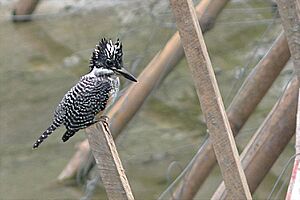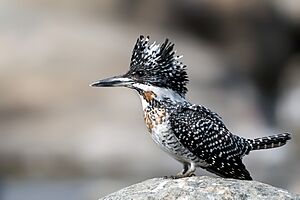Crested kingfisher facts for kids
Quick facts for kids Crested kingfisher |
|
|---|---|
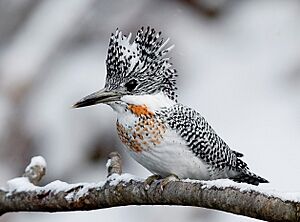 |
|
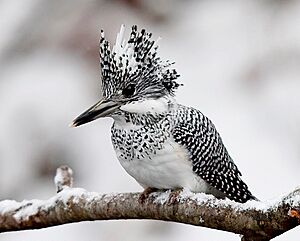 |
|
| Male (top) and female (bottom) M. lugubris subsp. pallida at Asahikawa city in Japan | |
| Conservation status | |
| Scientific classification | |
| Genus: |
Megaceryle
|
| Species: |
lugubris
|
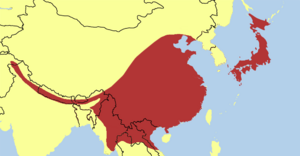 |
|
| approximate distribution | |
The crested kingfisher (Megaceryle lugubris) is a very large kingfisher bird. It lives in parts of southern Asia, from India all the way to Japan. This bird is related to three other types of kingfishers in the Megaceryle group.
About Its Name
The crested kingfisher got its scientific name, Megaceryle lugubris, from a Dutch scientist named Coenraad Jacob Temminck in 1834. The name Megaceryle comes from ancient Greek words meaning "great kingfisher." The word lugubris is Latin and means "mournful."
There are four main types, or subspecies, of the crested kingfisher. These different types live in various parts of Asia.
What It Looks Like
The crested kingfisher is a very big bird, about 41 to 43 centimeters (16 to 17 inches) long. It has black and white feathers and a shaggy, messy-looking crest of feathers on its head.
Its wings and tail have even black and white stripes. Unlike some other birds, it doesn't have a stripe above its eye. Its chest has spots, which are sometimes mixed with a reddish-brown color.
Where It Lives
This bird lives in the Himalayas and the mountain areas of northern India, Bangladesh, northern Indochina, Southeast Asia, and Japan. You can mostly find crested kingfishers near mountain rivers and larger rivers in the lower parts of mountains.
How It Behaves
Building a Nest
Crested kingfishers build their nests by digging a burrow into a vertical dirt bank. These banks are often found in forests, sometimes near a stream or a ravine. The nest can even be up to 1.5 kilometers (about 1 mile) away from water.
Both the male and female kingfishers work together to dig the burrow. They use their feet and bills to make a tunnel that is about 10 to 15 centimeters (4 to 6 inches) wide and 2 to 3 meters (6.5 to 10 feet) long.
The female kingfisher lays 4 to 7 eggs and is the only one who sits on them to keep them warm. Once the baby birds hatch, both parents help feed them. The young kingfishers stay in the nest for about 40 days before they are ready to fly out on their own.
Its Future
Scientists have noticed that the number of crested kingfishers has gone down in northeastern China. This decline is thought to be because their natural homes are being destroyed.



